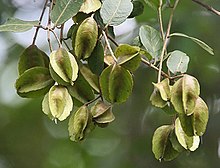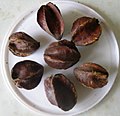Terminalia arjuna
| Terminalia arjuna | |
|---|---|

| |
| Arjuna fruit | |

| |
| Arjuna flowers with a Sykes's warbler | |
| Scientific classification | |
| Kingdom: | Plantae |
| Clade: | Tracheophytes |
| Clade: | Angiosperms |
| Clade: | Eudicots |
| Clade: | Rosids |
| Order: | Myrtales |
| Family: | Combretaceae |
| Genus: | Terminalia |
| Species: | T. arjuna
|
| Binomial name | |
| Terminalia arjuna (Roxb.) Wight & Arn.
| |


Terminalia arjuna is a tree of the genus Terminalia. It is commonly known as arjuna[1] or arjun tree in English.[2] It is used as a traditional medicinal plant.[3]
Description
[edit]T. arjuna grows to about 20–25 metres tall; usually has a buttressed trunk, and forms a wide canopy at the crown, from which branches drop downwards. It has oblong, conical leaves which are green on the top and brown below; smooth, grey bark; it has pale yellow flowers which appear between March and June; its glabrous, 2.5 to 5 cm fibrous woody fruit, divided into five wings, appears between September and November.[1][2]
The tree does not suffer from any major diseases or pests, but it is susceptible to Phyllactinia terminale and rot due to polystictus affinis.[4]
Distribution and habitat
[edit]The arjuna is seen across the Indian Subcontinent, and usually found growing on river banks or near dry river beds in Uttar Pradesh, Bihar, Maharashtra, Madhya Pradesh, West Bengal, Odisha and south and central India, Karachi Pakistan along with Sri Lanka and Bangladesh.[1][5] It has also been planted in Malaysia, Indonesia and Kenya.[4]
Importance
[edit]Silk production
[edit]The arjuna is one of the species whose leaves are fed on by the Antheraea paphia moth which produces the tassar silk, a wild silk of commercial importance.[6]
Gallery
[edit]-
Terminalia arjuna
-
Terminalia arjuna middle trunk
-
Terminalia arjuna leaves
-
Inflorescence of Terminalia arjuna
-
Pollen grains of Terminalia arjuna
-
Arjuna fruits (dried)
-
Terminalia arjuna in Bagh-e-Jinnah, Lahore
-
The bark of Terminalia arjuna (অর্জুন) is found in Bana Bitan, Kolkata, West Bengal, India
References
[edit]- ^ a b c Biswas, Moulisha; Biswas, Kaushik; Karan, Tarun K; Bhattacharya, Sanjib; Ghosh, Ashoke K; Haldar, Pallab K (2011). "Evaluation of analgesic and anti-inflammatory activities of Terminalia arjuna leaf". Journal of Phytology. 3 (1): 33–8.
- ^ a b "Arjun Tree". Eco India.
- ^ M Iqbal Zuberi (2012). "Flora". In Sirajul Islam; Miah, Sajahan; Khanam, Mahfuza; Ahmed, Sabbir (eds.). Banglapedia: the National Encyclopedia of Bangladesh (Online ed.). Dhaka, Bangladesh: Banglapedia Trust, Asiatic Society of Bangladesh. ISBN 984-32-0576-6. OCLC 52727562. OL 30677644M. Retrieved 6 March 2025.
- ^ a b The CABI Encyclopedia of Forest Trees. 2013. p. 464. ISBN 9781780642369.
- ^ Rastogī, Rekhā (2008). Let Us Identify The Useful Trees(New). Children's Book Trust. p. 7,8. ISBN 978-81-7011-919-7.
- ^ M.P. Shiva. "Non-wood forest products In 15 countries of Tropical Asia". Food and Agriculture Organization of the United Nations.
 Media related to Terminalia arjuna at Wikimedia Commons
Media related to Terminalia arjuna at Wikimedia Commons Data related to Terminalia arjuna at Wikispecies
Data related to Terminalia arjuna at Wikispecies








